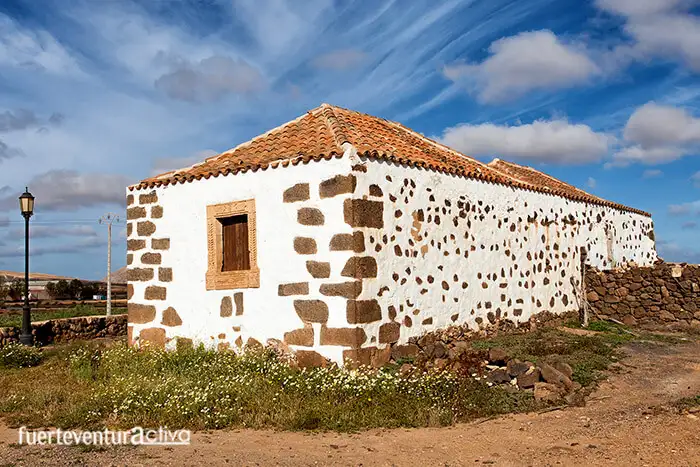What to see in Fuerteventura ?
What to visit in La Oliva?
The town of La Oliva, north of Fuerteventura, is the head of its municipality
As this part of the island is flat, fertile and has good pastures, it has favored human settlement since pre-Hispanic times.
In the 16th century it began to be populated by new settlers. Here a fundamentally agrarian society was established, dedicated to the cultivation of cereal, potatoes, and various legumes. Goat farming was the second most important economic sector in La Oliva.
Thanks to this economic boom, emblematic buildings were built that are worth visiting.
Candelaria Church

The church of Nuestra Señora de la Candelaria dates from the early seventeenth century. It is the second church that was built in the town. The first was the hermitage of La Virgen del Rosario, of which today only a small cross remains that reminds us of its past.
The church of La Candelaria was built for two essential reasons. One of them, because the hermitage of Rosario, was not able to accommodate the number of parishioners in the area. And the other, and more important, because when the high bourgeoisie settled in the town they wanted a church according to their status.
The church of La Oliva has three attached naves, a differentiated altar behind a main arch and a choir at the foot.

On the south side of the façade stands the bell tower, with a square plan and made of dark stonework. In addition to being a bell tower, the tower served as a lookout point, giving warning against possible pirate attacks.
The naves are arranged separated by columns of light stonework that support semicircular arches. The roof of the three naves are simple Mudejar style trusses
The most remarkable works of the northern church are five oil paintings on canvas that adorn the Main Altarpiece, and which are attributed to Juan de Miranda, considered the most important painter in the Canary Islands of the 18th century.
Nor can you miss the painting of souls, donated by Don Melchor de Cabrera and Doña Ana de Cabrera y Bethéncourt in 1732. Among the curiosities that the church of La Oliva houses, is its close relationship with Freemasonry. In the church there are several iconographic winks, which remind us of belonging to the Masonic lodges of prominent residents of the town. An example of this is at the entrance to the temple. On one of its steps, “The All-Seeing Eye” (an equilateral triangle and inside the divine eye) was recorded.
The House of the Colonels

La Casa de los Coroneles is the most remarkable civil building in La Oliva. It was built at the beginning of the 18th century, when the military militias of Fuerteventura and the figure of the Colonel were created.
The Colonels held the military and civil power of the time, naming and dismissing the positions of the Cabildo at their will. They became landowners, monopolizing much of the island’s heritage. They accumulated the largest economic capital on the island. The Colonels of Fuerteventura were a closed society. The appointment of the Colonels became for life and hereditary. The mansion built by the Sánchez Umpiérrez family and inhabited by their successive lineages is the so-called Casa de los Coroneles.
From the outside of the building, both its dimensions and two crenellated towers, erected on its main façade, are impressive. The purpose of these towers, typical of military architecture, was to show the power of their owners to the people. The interior is distributed around a two-story patio with wooden galleries. The patio itself shows lush vegetation. On the ground floor were the service rooms, stables, barn, warehouse, bakery, etc. It is currently used to host various exhibitions and artistic proposals.

The upper floor was where the gentlemen carried out their daily lives. A huge hall, a small chapel and several rooms stand out, most of them with beautiful wooden floors and ceilings. Around the Casa de los Coroneles there are a series of buildings worth seeing, even if they are in ruins.
Chapel of the Capellanía

The hermitage of the Capellanía, or Puerto Escondido, is located just one hundred meters from the Casa de los Coroneles. It was built at the beginning of the 16th century. It was the home of the first clergyman in the town, when the area was called “Puerto Escondido.” The building was divided into two: the house and the space where masses and liturgical acts were celebrated.

What is most striking about this small hermitage are the elaborate stonework filigree works that are displayed on door and window frames.
La Cilla – Museum of grain
Now it’s time to go to the other side of town. Crossing the main road and taking La Orilla street you will find, two hundred meters from the church, another property that you cannot miss on your visit to La Oliva: La Casa de La Cilla. The cillas were warehouses belonging to the church. There the grain from the payment of taxes was kept-

The tax to pay was ten percent (diez por ciento in spanish) of the entire harvest harvested, that’s why it was called diezmo.
Casa de La Cilla is made up of the cilla warehouse, which has a rectangular shape and the tazmiero’s house, in the shape of an “L”. The tazmiero was the one who made the so-called “book of tazmía”, an account book that reflected the name and the amount of the diezmo of each of the farmers. In it, farm implements and other tools are displayed, which together with information panels will help you understand the importance of cereal in Fuerteventura.
Where to stay in La Oliva?
At FuerteventurActiva we have accommodation in the historic center of La Oliva, and three more less than 10 minutes away by car.
Accommodations to make you feel at home: Seña Catalina.
Villas con piscina privada: Casa Mina, Casa Susana, Casa La Vera.
Fuerteventura4





